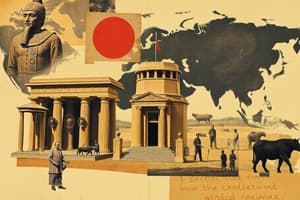Podcast
Questions and Answers
In which region did early civilizations emerge around 3500 BCE?
In which region did early civilizations emerge around 3500 BCE?
- The Nile River Delta
- Mesopotamia (modern-day Iraq) (correct)
- The Indus Valley
- Ancient Egypt
What was a key feature of the Sumerian City-States in Mesopotamia?
What was a key feature of the Sumerian City-States in Mesopotamia?
- A focus on law, trade, and cultural achievements
- A unified empire under a single ruler
- Independent cities with their own governments and rulers (correct)
- A strong pharaonic system with divine rulers
Who is credited with creating the Code of Hammurabi in Mesopotamia?
Who is credited with creating the Code of Hammurabi in Mesopotamia?
- Gilgamesh
- Ashurbanipal
- Sargon of Akkad
- Hammurabi (correct)
What is a notable feature of the Ancient Egyptian civilization?
What is a notable feature of the Ancient Egyptian civilization?
In which period of Ancient Egyptian history was there a focus on military expansion and empire building?
In which period of Ancient Egyptian history was there a focus on military expansion and empire building?
What is a characteristic of the cities established in Mesopotamia during the early civilization period?
What is a characteristic of the cities established in Mesopotamia during the early civilization period?
Flashcards are hidden until you start studying
Study Notes
Early Civilizations
- Emerged around 3500 BCE in Mesopotamia (modern-day Iraq)
- Characterized by:
- Development of writing (cuneiform)
- Establishment of cities (e.g., Ur, Babylon)
- Creation of complex societies with social hierarchies
- Development of trade and commerce
Mesopotamian Empires
- Sumerian City-States (3500-2300 BCE):
- Independent cities with their own governments and rulers
- Notable rulers: Sargon of Akkad, Gilgamesh
- Akkadian Empire (2300-2100 BCE):
- Unified Mesopotamia under a single ruler (Sargon)
- Expanded empire through conquests
- Babylonian Empire (1800-539 BCE):
- Established by Hammurabi, who created the Code of Hammurabi
- Focused on law, trade, and cultural achievements
Ancient Egypt
- Emerged around 3100 BCE
- Characterized by:
- Development of hieroglyphic writing
- Construction of pyramids (e.g., Great Pyramid of Giza)
- Strong pharaonic system with divine rulers
- Advanced knowledge of mathematics and medicine
Egyptian Dynasties
- Old Kingdom (2613-2181 BCE):
- Period of pyramid construction and strong pharaonic rule
- Notable pharaohs: Khufu, Sneferu, Khafre
- Middle Kingdom (2040-1750 BCE):
- Period of cultural and economic growth
- Notable pharaohs: Mentuhotep II, Amenemhat I
- New Kingdom (1570-1085 BCE):
- Period of military expansion and empire building
- Notable pharaohs: Hatshepsut, Thutmose III, Ramses II
Early Civilizations
- Mesopotamia, modern-day Iraq, saw the emergence of early civilizations around 3500 BCE
- Key characteristics of these civilizations include:
- Development of writing systems like cuneiform
- Establishment of cities like Ur and Babylon
- Creation of complex societies with social hierarchies
- Development of trade and commerce
Mesopotamian Empires
Sumerian City-States
- Existed from 3500-2300 BCE
- Characterized by:
- Independent cities with their own governments and rulers
- Notable rulers of the time include:
- Sargon of Akkad
- Gilgamesh
Akkadian Empire
- Lasted from 2300-2100 BCE
- Key characteristics:
- Unified Mesopotamia under a single ruler, Sargon
- Expanded empire through conquests
Babylonian Empire
- Existed from 1800-539 BCE
- Established by Hammurabi, who created the Code of Hammurabi
- Key focus areas:
- Law
- Trade
- Cultural achievements
Ancient Egypt
- Emerged around 3100 BCE
- Key characteristics:
- Development of hieroglyphic writing
- Construction of pyramids, such as the Great Pyramid of Giza
- Strong pharaonic system with divine rulers
- Advanced knowledge of mathematics and medicine
Egyptian Dynasties
Old Kingdom
- Lasted from 2613-2181 BCE
- Key characteristics:
- Period of pyramid construction and strong pharaonic rule
- Notable pharaohs of the time include:
- Khufu
- Sneferu
- Khafre
Middle Kingdom
- Lasted from 2040-1750 BCE
- Key characteristics:
- Period of cultural and economic growth
- Notable pharaohs of the time include:
- Mentuhotep II
- Amenemhat I
New Kingdom
- Lasted from 1570-1085 BCE
- Key characteristics:
- Period of military expansion and empire building
- Notable pharaohs of the time include:
- Hatshepsut
- Thutmose III
- Ramses II
Studying That Suits You
Use AI to generate personalized quizzes and flashcards to suit your learning preferences.




